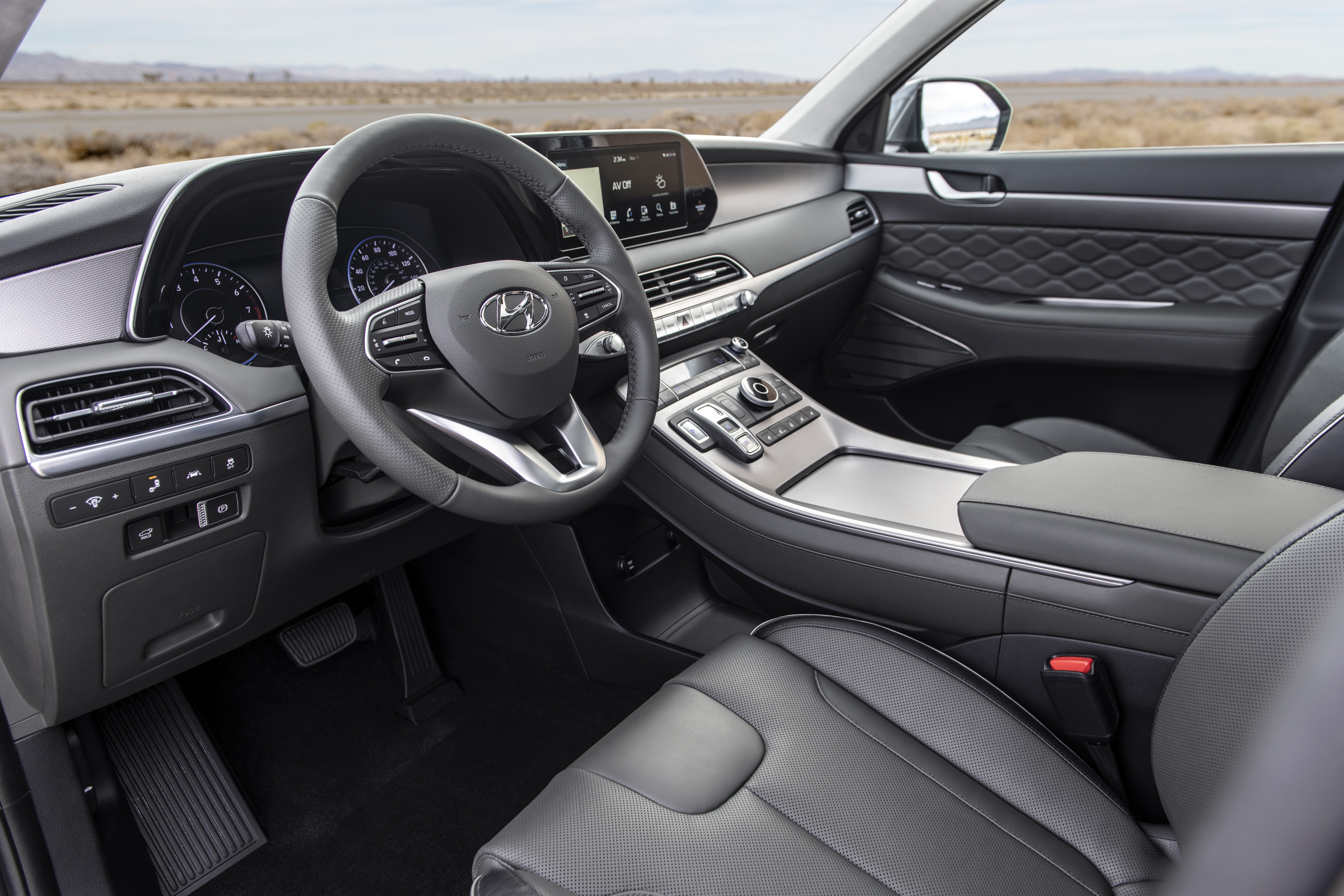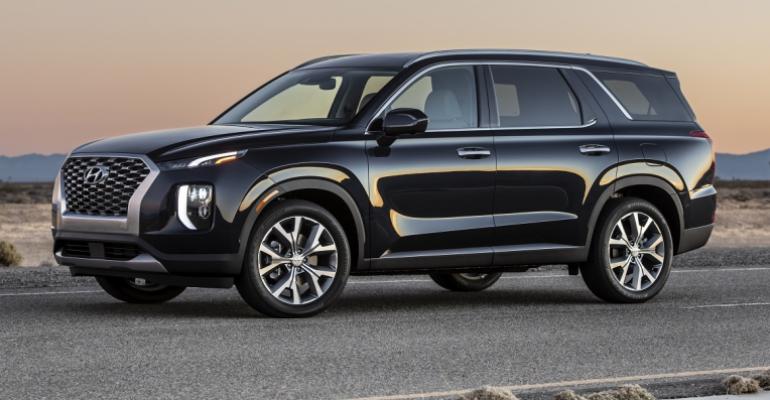Hyundai reveals photos and details of its new Palisade large CUV today at the 2018 Los Angeles auto show.
Replacing the long-wheelbase Santa Fe XL in Hyundai’s U.S. lineup, the brand considers the Palisade its new flagship vehicle.
“In the old days we’d say the Azera (large sedan) would be our flagship product, but really the market’s changed so much that now our flagship product really should be an SUV,” Mike O’Brien, vice president-product, corporate and digital planning, tells media Nov. 8 at an L.A. show preview at the automaker’s Superior Twp., MI, tech center.
Thanks to new (Subaru Ascent, Volkswagen Atlas) and redesigned (Chevy Traverse, Mazda CX-9) entrants, sales in Wards Intelligence’s Large CUV segment were up 22.3% through October.
While their share of total CUV sales in the U.S. stood at 6.2% through October, up from 5.8% for calendar 2017, Large CUVs’ slice of the total CUV pie has been trending down each year since 2013 as Small CUVs, such as Hyundai’s own Kona, the Subaru Crosstrek and the Honda HR-V, have grown volume faster and Middle CUVs also have lost share.
Wards Intelligence’s Small CUV group had 19.7% share of total U.S. CUV sales through October, up from 16.5% last year and 10.3% in 2013.
While Hyundai refers to the Palisade as an SUV, the vehicle rides on a unibody platform, albeit one that is a fair bit longer and wider than the old Santa Fe XL’s. It also is shared with sister-brand Kia’s new large CUV, the Telluride.
“Where it makes sense, there’s a lot of commonality,” says John Juriga, director-powertrain systems for Hyundai/Kia in North America, says of the platform/module.
O’Brien notes the Palisade’s added width over the Santa Fe XL – 3.6 ins. (91 mm) – was an especially important Hyundai development goal, to make getting in and out of the third row easier.
“The biggest problem with the outgoing (7-passenger Santa Fe XL) model was, not only was it too narrow for a three-(person) across third-row seat, but it was really too narrow to have easy ingress and egress to that third row between the captain’s chairs and the second row,” he says, noting the added width also raises the feeling of spaciousness inside the Palisade.
The Palisade, on sale next summer in the U.S., will come standard with a second-row bench seat, bringing total seats to eight, but offer an optional captain’s chair configuration.
O’Brien says the increased dimensions, sense of spaciousness and an overall sense of premium-ness pushed Hyundai in the direction of bringing out a new nameplate, rather than carrying over the Santa Fe XL name or even resurrecting the Veracruz moniker. The Veracruz 3-row CUV lived from 2007 through 2011 in the U.S. before being discontinued.
“As marketers we have to think very carefully about (marketing costs) because now we have to develop the awareness of an all-new nameplate, (but) this product shares virtually nothing with the Santa Fe,” O’Brien says, although he notes the platforms or “modules” for the Palisade and Santa Fe do share some commonality, despite the vehicles’ different dimensions.
As for the Veracruz, he says its image was good, but awareness among non-Hyundai vehicle owners was low
Unique among Hyundai utility vehicles the Palisade is not named after a warm-weather North American city. O’Brien says the name Palisade still elicits a sense of place and is a reference to high cliffs and “the strength of a fortress.”
Strength and sophistication were exterior design targets and he says the vehicle reflects strength in its large dimensions (it is Hyundai’s largest U.S. utility vehicle), but sophistication comes from its surfacing.
“One of the things I like to compare it to is Cadillac,” O’Brien says. “Cadillac has done a fabulous job of using flush surfacing as a key communicator of premium. It’s very expensive for engineers and designers to have very flush surfacing, where the glass meets the sheet metal, where the trim meets the sheet metal, where the lamps meet the sheet metal, where the bumper covers join.
“So those radii and those joints are very expensive to make a flush surface,” he continues. “And when you study this car closely, you’ll see that a lot of extra effort was placed on flush surfacing to give it a very elevated and very premium feeling in terms of its execution and design.”
Meanwhile, interior design is “very futuristic and very, very premium, not only in design execution but also in the materials and the way we distribute space across the interior. It gives a sense of really strong, airy presence in terms of space.”
In addition to the added width and a longer wheelbase, spaciousness also comes from pushing the instrument panel down by using a tablet-style display screen, while a shift-by-wire gear selector frees up space for storage for bags in the center console.

The Palisade’s main display screen is a 12.3-in. (31-cm) LCD and its gauge-cluster screen is a 12.3-in. high-definition TFT.
With the vehicle Hyundai introduces an in-car intercom (similar to those available in select U.S. minivans), but with a sleep mode to only direct sound, for instance, to the second row when children are sleeping in the third row.
Second-row seats are said to be “one-touch” to move so children can access the third row without their parents’ help.
For kid safety, Hyundai will have available from the Santa Fe its safe-exit assist feature, which uses the blindspot system’s side sensors to detect if a pedestrian or bicyclist is approaching from the rear and prevent a back door from opening.
There also is a rear-occupant alert, which via ultrasonic sensors looks for the presence of a child or pet in the rear of the vehicle. Drivers get a center-cluster warning upon exiting the vehicle and, if ignored, an external loud beep. If that is ignored, a notification is sent via Hyundai’s Bluelink telematics service to an owner’s phone.
The Palisade comes with standard front-wheel drive and has optional all-wheel drive in collaboration with Magna.
“The Magna center coupling that we developed with our partners in Germany gives us a predictive capability which means we’re already taking care of…a yaw condition or slip-y wheel condition – many times before the driver ever knows it’s happening,” O’Brien says, adding torque vectoring also is present and helps give a more stable turn-in feeling that reduces understeer.
Comfort, smart, sport and snow modes are available, with comfort allowing for a torque split to the rear axle up to 50% depending on sensor capability. Smart mode optimizes for fuel economy and drivability; sport mode gives a 65/35 to 50/50 split for more aggressive driving and uses torque vectoring more aggressively; and snow mode predistributes AWD traction and in essence forces a second-gear start to minimize wheel slip on initial acceleration.
The Palisade uses Hyundai’s 8-speed automatic transmission from the Santa Fe and other models as well as an updated version of the 3.8L gasoline-direct-injected Lambda V-6 from the Genesis luxury-car lineup.
To get the kind of performance and fuel economy Hyundai wanted, the automaker employs Atkinson cycle, with late intake valve closing made possible by mid-position lock, fast-response continuously variable valve timing. Hyundai also uses a long-duration camshaft on the mill.
The engine’s compression ratio has been increased to a maximum 13.0:1 from 11.5:1 with the 3.8L V-6 in the Genesis G90.
Horsepower of the Palisade engine is rated at 291 at 6,000 rpm, down from 311 hp @ 6,000 rpm in the G90. Torque is 262 lb.-ft. (355 Nm) but at what rpm is not given. The G90’s V-6 hits peak torque of 293 lb.-ft. (397 Nm) at 5,000 rpm.
The 262-lb.-ft. torque rating gives the vehicle plenty of power for towing, Juriga says. The standard tow rating is 5,000 lbs. (2,268 kg), but Hyundai will offer a Class 3 hitch at dealers.





